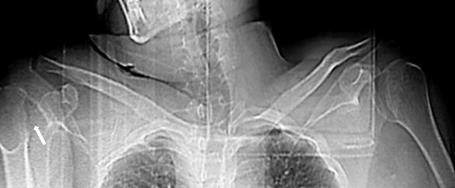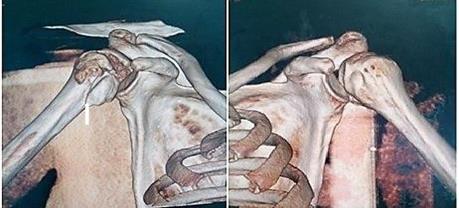

Figure1: fracture of the right
upper end of the humerus
with posterior bilateral dislocation

Figure 2: treatment
result followed up at 6 months
Discussion:
Posterior shoulder dislocations are usually seen in high-energy trauma. Epileptic seizures, electrocution, and electroconvulsive therapy were rarely described
as unique cause.
Bilateral involvement caused by generalized tonic seizures
was always described
in previously known epileptic patient [3]. The mechanism of shoulder
injury during a seizure
involves a violent contraction of the medial rotator muscles which remain unbalanced by the lateral rotator’s forces. Posterior
fracture-dislocation is usually due to an increased stress on the notched
anatomical neck against the glenoid
during long contractions [4,5]. Different
kinds of fractures
have been described
in association with shoulder dislocation. However, there is no specific classification available [6]. Posterior dislocation of the shoulder is initially misdiagnosed in 50 to 80% of cases. Patients usually have enough motion and minimally
palpable humeral displacement. This leads
the clinician for inappropriate imaging
request and decrease the chance to confound
the dislocation diagnosis. However,
a careful clinical examination should always
suspect it for known mechanisms using dedicated
shoulder protocol
with high suspicion
index [7,8].
The inspection of a patient with shoulder
posterior dislocation reveals a prominent coracoid
and anterior glenohumeral void caused
by the posterior position
of the humeral head. The examination of the shoulder shows a limitation in the range of motion respecting
passive external rotation and abduction
due to the impaction humeral
head against the posterior glenoid rim [9]. Posterior
dislocation may be missed initially on conventional frontal radiographs in 50% of cases, as the humeral head could appear normally aligned with the glenoid.
An axillary view is a preferred view for diagnosis. Alternatively, a Velpeau,
Wallace or scapular Y views can be useful [10-12]. Cross-sectional imaging
(CT or MRI) is often used to assess articular surface injuries
(reverse Hill-Sachs lesion), glenoid
injuries (reverse
Bankart lesion) or ligamentous injuries. This assessment is mandatory before surgical management [13]. The diagnosis delay leads to increased
morbidity. Posterior dislocation usually produces
an impression fracture
on the anterior aspect
of the humeral head. The fracture can
propagate and damage the articular
cartilage. This may lead to and eventual from impaired
blood flow to the humeral
head can lead to osteoarthritis and avascular
necrosis of the humeral head. Only early diagnosis can reduce the risk of these complications [14]. Our patient
had none despite
late management. Treatment
options are various. The indication depends
on several factors. The age of the patient,
the size of the humeral
head defect, unilateral or bilateral nature,
the degree of instability and the duration of dislocation are important
factors to consider before the decision. Treatment modalities
include rotational osteotomy of the proximal humerus, transposition of the subscapularis tendon
or the lesser tuberosity into the defect, or bone grafting. Shoulder
arthroplasty should
be reserved for large defects and neglected
dislocations [15-17].
Conclusion:
Our patient is another
case of missed bilateral shoulders fracture-dislocation. He was treated
with modified
McLaughlin Procedure
and physiotherapy. This technique
consists of transplanting the lesser tuberosity with the attached
subscapularis tendon
into the anteromedial defect. This technique It provided a good stability, immediate active motion
restoration, and allowed a quick socio-professional reinsertion.
Conflict of interest: none
References:
[1] J Kasha S, Bandari
G. Bilateral Posterior Fracture-Dislocation
of Shoulder Following
Seizures Secondary to Cavernous Sinus Venous Thrombosis - A Rare Association. Orthop
Case Rep. 2018; 8:49-52.
[2]Gurzi MD, De Meo D, Pugliese M, Di Giorgio
L, Persiani P, Villani C. Bilateral
posterior fracture-dislocation of the shoulder
after epileptic seizure. Trauma Case Rep. 2017; 13:35-41.
[3] Sharma A, Jindal S, Narula MS, Garg S, Sethi A. Bilateral
Asymmetrical Fracture Dislocation of Shoulder
with Rare Combination of Injuries after Epileptic Seizure: A Case Report.
Malays Orthop J. 2017; 11:74-76.
[4]Connor-Read L, Bloch B, Brownlow
H. A missed orthopaedic injury following
a seizure: a case report. J Med Case Rep. 2007; 1:20.
[5] Mnif H, Koubaa
M, Zrig M, Zrour S, Amara K, Bergaoui N, et al. Bilateral
posterior fracture dislocation of the shoulder.
Chir Main. 2010; 29:132‑34.
[6]Chalidis B, Papadopoulos P, Dimitriou C. Reconstru - ction of a missed posterior
locked shoulder fracture-dislocation with bone graft
and lesser tuberosity transfer: a case report.
J Med Case Rep. 2008; 2:260.
[7]Pushpakumara J, Sivathiran S, Roshan L, Gunatilake S. Bilateral posterior fracture-dislocation of the shoulders
following epileptic seizures: a
case report and review
of the literature. BMC Res Notes.
2015; 8:704.
[8] Sharma D, M K, R NA, Poduval
M, Patro DK Asymmetrical Fracture Dislocation of Shoulder
- A Case Report and Review of Literature. J Orthop Case Rep. 2013; 3:19-22.
[9]Amir MA, Alenazi
B, Wyse RK, Tamimi
W, Kujan O, Khan T, Alenzi FQ. Neglected Bilateral Posterior Shoulder Fracture Dislocation in an Uncontrolled Seizure patient. Pak J Med Sci. 2015; 31:1018-20.
[10]Kowalsky MS, Levine WN. Traumatic
posterior glenohumeral dislocation: classification, pathoanatomy, diagnosis,
and treatment. Orthop Clin North Am. 2008; 39:519‑33.
[11]O'Neill D, Nair JR, Binymin KA. Simultaneous bilateral posterior fracture dislocation
of the shoulders in a
young man with unexpected severe vitamin D deficiency. Int J Gen Med. 2012; 5:399-402.
[12]Aparicio G, Calvo E, Bonilla
L, Espejo L, Box R. Neglected
traumatic posterior dislocations of the shoulder: controversies on indications for treatment
and new CT scan findings.
J Orthop Sci Off J Jpn Orthop Assoc. 2000; 5:37‑42.
[13] Sunku N, Kalaiah K, Marulasidappa G, Gopinath P. Bilateral Anterior Fracture-Dislocation of Shoulder
Joint- A rare case with Delayed Presentation. J Orthop Case Rep. 2012; 2:7-9.
[14]Uppal HS, Robinson PW, Packham I,
Crowther M. The management of bilateral
posterior fracture dislocations of the shoulder:
a case series illustrating management options. Shoulder Elbow. 2016; 8:111-7.
[15]Elmali N, Tasdemir Z, Saglam F, Gulabi D, Baysal O. One-stage surgical treatment of neglected
simultaneous bilateral
locked posterior dislocation of shoulder:
a case report and literature review. Eklem Hastalik Cerrahisi. 2015; 26:175-80.
[16]Jagath P, Sivagamaroobasunthari S, Lasantha R, Saman G. Bilateral posterior fracture-dislocation of the shoulders following epileptic seizures: a
case report and review
of the literature. BMC Res Notes. 2015;
8:704.
[17]Konda SR, Fisher N, Gage M, Egol KA. Posterior Fracture Dislocation of the Shoulder:
A Modified McLaughlin Procedure. J Orthop Trauma.
2017;31 Suppl 3: S36-S37.
Citation: Layouni S, Naija S, Hassine A, Douma R,
Ben Amor S. Bilateral posterior
fracture-dislocation of the
shoulder after epileptic
seizures: A case report.
Junior Medical Research. 2019; 2(1):13-17.
Layouni et al © All rights are reserved.
Submit your manuscript: www.jmedicalresearch.com




